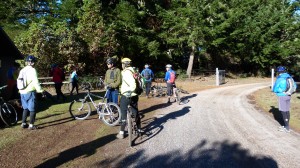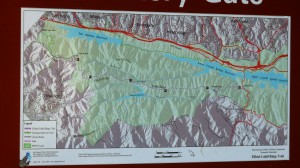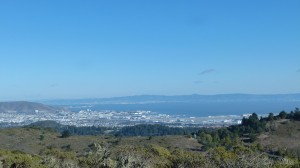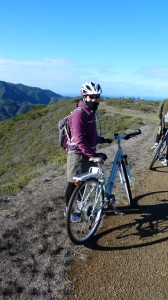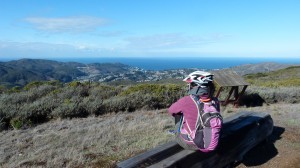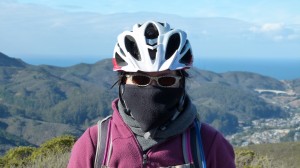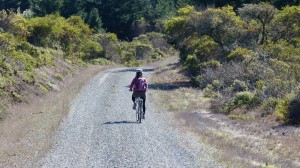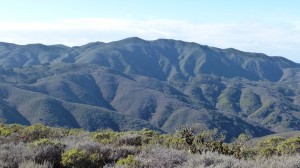About two weeks ago I bought a bike. Brand new, cute as can be, even with a name, "Fiona". I also got the cutest panier ever, with a lime green flower and orange straps.
[singlepic id=477 w=320 h=240 float=center]
On my very first ride, I got a flat tire. A complete blow out, requiring me to walk it home for about two miles. Luckily it was a particularly beautiful sunset on the ocean, and I got to look up, twisting my head slowly to savor the powder blue sky and cotton candy pink clouds spreading in all directions around me.
[singlepic id=478 w=320 h=240 float=center]
Still, I was a little shaken by the fact that the road looked so innocent - no broken glass or bed of nails in sight. Just smooth blacktop for as far as the eye could see. Except for whatever jumped into my back tire that evening.
It turned into a perfect opportunity to have one of my coworkers show me how to change a flat. Somewhere around step 9 of the process, my eyes started to glaze over, but I kept taking notes as he explained and demonstrated patiently. He taught me about tire protectors and now I own some. If you don't have them, go get some!
I've been riding almost every day since. On the sunny ones, I'm riding chin up, smiling from ear to ear, and taking in the sounds of the rolling waves and the expansiveness of the ocean stretching out to the horizon. I note the particular shade of blue in the sky and on the water each day, because they are never repeated exactly.
Riding my bike has transformed a routine errand - hopping in my car to drive two miles to the local market for food each day - into a celebration of life. I breathe in the scent of cypress, I feel the warm sunshine on my cheeks, and I experience my own body propelling this amazing machine beneath me.
I wonder, “How the bicycle must have transformed human experience when it first appeared on this planet!”
And then I think, "What made us dream of a bigger machine that would multiply our speed of transit even more, but not require us to move our bodies at all?"
When I'm sitting on my bike, gliding along the paved path near the ocean, I think about these things. I am relaxed and confident, because this is a bike's territory. Pedestrians and dogs must yield.
[singlepic id=479 w=320 h=240 float=center]
A different story begins the minute I cross from the path to the road. The very last stretch of ride between my house and the market involves crossing a major intersection with a stoplight. Four lanes of traffic, three strip malls, a gas station, a high school, all converge at one point. I have two streets to cross each time I reach this intersection. I walk across one way, and ride across the other, my body often tense with resolve to "get through" without any close encounters with cars or mishaps with my own machine beneath me.
One day last week, I was feeling particularly vulnerable. It was drizzling lightly. I liked being alone on the path, feeling the cool breeze in my ears, and the tiny fuzzy droplets of mist gathering on my eyelashes. I was cautious, using the brakes a bit more on the turns, controlling my speed, as I had no idea how Fiona would respond in wet conditions.
Traffic was slow on the main highway. Cars inched along, and it was only three o'clock. The high school had just gotten out, so large groups of kids congregated at the crosswalks, on their way home or to the adjacent strip mall.
I gritted my teeth and got through the stoplight. My pant leg got caught momentarily as I mounted to start to go across, and I had a slight moment of panic. I didn't want to be seen falling in the middle of the intersection! I started over, gathered my composure, and made my way across without a problem, although I was muttering some phrases to myself under my breath anyway. I hated that feeling of vulnerability, of having to depend on my body and this foreign thing underneath me to work properly in order to ensure my safe passage.
I did my shopping, filling my panier to the brim with beautiful vegetables and dinner fixings. I was ready to go home. But I had to get back across the hairy intersection first.
I took a slightly different route, making my way around the back of the store, thinking I would use a pedestrian crosswalk in the middle of the block. There was no easy way to get back to that stoplight. Cars came from four different directions - a parking lot, a side street, and two directions on the main road. A large group of high school kids – mostly boys – was hanging out on the sidewalk, directly in front of the pedestrian crosswalk. Most of them were looking down, kicking the ground, their hands shoved into their pockets, as if they were waiting for something. As I approached them, I felt an ancient but familiar wave course through my body – like prickles, spreading from my hands up to my neck, a tensing, a holding of my breath, a desire to "get through" this without being noticed, without embarassing myself.
Me, on my brand new Fiona with a brand new panier overflowing with vegetables, wearing a bright green rainshell and bright white helmet. Everything so bright and brand new. Who wouldn't notice that?
I changed my plans and kept riding.
I passed the group of boys and proceeded to the next parking lot entrance, thinking I could position myself to cross the street with the cars. Several minutes – or what seems like several minutes -- went by, and it was clear that drivers are not going to make space for me. I would have to “be aggressive” and act like a car, or wait. So, I decided to retrace my path by half a block back to the pedestrian crosswalk.
I never looked at any of those high school boys, but I felt them watching me as I approached. This, of course, made me avoid eye contact totally. They were spitting, laughing, and yelling things every now and then. As I looked over my left shoulder and waited with one foot poised on the pedal of my bike, I felt ashamed that I wasn't "aggressive enough" to cross the street as if I were another car, or, like some bikers, as if I owned the right of way. I felt lame for having retraced my route by half a block, just to use the pedestrian crosswalk. I waited, and I watched, and I found my window to cross. During those few seconds, I heard one boy's voice shout, "CHINESE PEOPLE!" I didn't look back. I couldn't. I felt a sting of pins and needles spread throughout my body, and all of my attention went toward getting out of there as fast as I could.
As I pedaled away, I recalled the incidents - yes, plural - from my childhood that had made me feel the same way. They were so long ago, but in that moment immediately came back into focus. I had been called "Chinese, Japanese, dirty knees, if you please" starting in first grade. I had been taunted with, "Gook!" yelled at me from open car windows as I commuted on foot between the freshman building and the main building of my high school, where I took math class with the upperclassmen.
I knew exactly what these words meant, and I knew exactly what these people were making fun of - me. The slant of my eyes, the color of my hair, the whole history of a people that I didn't know and they probably didn't know either. I just looked like something funny and irrelevant to them.
I realized on that drizzly day, pedaling away from those boys, that the act of riding a bicycle is nothing short of revolutionary for me. None of the women in either of my parents' families ever learned to ride a bike. It was considered "too dangerous". That and swimming. From the stories I heard growing up, it seemed unnecessary for a girl to take such risks in the name of mere recreation and enjoyment. It was considered a privilege not to have to be physically active. It was a sign of refinement, education, and status. And there were no higher prizes than these in the Chinese culture that I learned about from my parents’ stories.
I never learned to ride a bike until second grade. That was late in my hometown of Libertyville, Illinois. It seemed to be a top priority in that suburb to teach your kids to swim, ride a bike, shoot a basketball, catch and throw a baseball. This is what the “All-American”, “normal” people in our neighborhood did for fun.
I learned to ride a bike mainly to avoid further embarrassment at school, to have one less reason not to fit in.
In my family, the priority for me was learning to play an instrument (two instruments, actually), learning to practice every day, focusing on building a skill in the solitude of our own home. No one at school really knew what I did at home, and I never found the words to explain it. One day a newspaper clipping announcing my first place win at a Chicago-area piano competition was tacked to the bulletin board of my fourth grade classroom. I felt the same sting of shame and embarrassment, like I didn't want anyone to see it, like I had to get out of there fast.
Why? I wanted to hide. I wanted to protect what I could protect, because anywhere I showed up, people would see my face. My slanty-eyed, unmistakably Chinese face, looking out at a sea of “All-American, normal” white faces. I could never hide my face, but I could hide what was in my heart, what I really cared about, what made me feel joyful and alive. No one could make fun of that if I kept it hidden, precious only to me.
I developed the habit of cultivating my most precious territory within me. It protected me, and I protected it. While others experienced me in performance, I experienced myself most deeply in the solitude of my own practice. I learned to love the stillness, silence, and solitude of practice. My practice – the sacred activities I do for myself, which now consist of yoga, meditation, singing, painting, writing, and bodywork – still brings me to the deepest feelings of love and connection in my life.
I'm grateful for my bike and for the fact that I learned to ride it.
On my bike, I get to experience my vulnerability in a tangible way. There is no hiding. I am not protected by the walls of the 4-wheel-drive SUV my brother insisted I drive after my second car accident in my twenties. "You need to be surrounded by a cage of steel," he said to me in his lovingly protective way, as he bought me a new car.
In my car, I can hide. I can blend in with the traffic, just "getting through" to my destination each time. I can look out the windows and think my thoughts about other drivers, bikers, pedestrians. No one will notice me, if I just get through. I can play a CD and drown out the rain. I can keep the windows up and not feel a breeze.
[singlepic id=476 w=320 h=240 float=center]
But my bike has taught me that there is an aliveness to being vulnerable. I feel the wind whipping by my ears, I hear the clicking of the gears and chains, I hear the swells and roars of the ocean waves, and I announce my presence to pedestrians by saying, "On your left!". I greet my fear each time I cross the highway, or, earlier this week, take a turn too quickly and crash into a fencepost. (Fiona and I are both doing fine.)
I feel both the rawness and the sweetness of being exposed. I feel more of everything when I am on my bike. I hear the birds singing and the highway patrol sirens blaring as they approach a wreck. I smell the eucalyptus trees, and the garbage waiting in cans for pickup. I recall ancient memories of shame, and I receive more reasons to appreciate my particular life story.
My bike taught me all of this, in only a few weeks. I plan to keep learning.

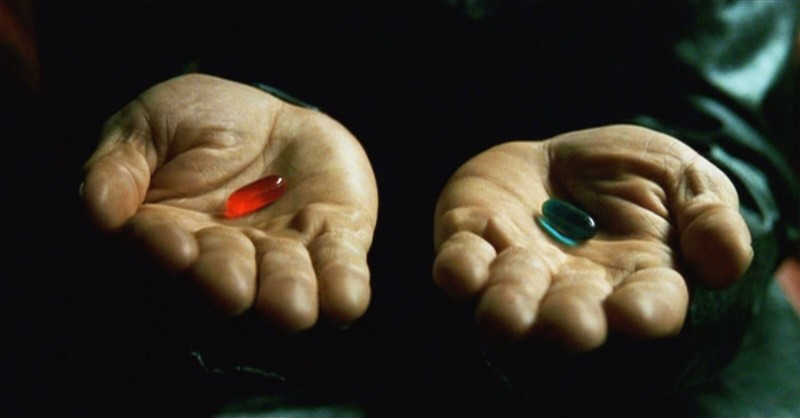 There is a scene in the movie, The Matrix, in which the main character Neo is offered a choice between the “red pill” and the “blue pill”.
There is a scene in the movie, The Matrix, in which the main character Neo is offered a choice between the “red pill” and the “blue pill”.